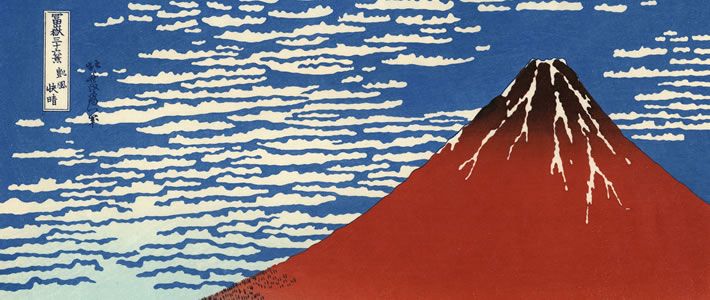
Mount Fuji in Edo Arts and Minds
Culture- English
- 日本語
- 简体字
- 繁體字
- Français
- Español
- العربية
- Русский
After viewing some woodblock prints on the subject of “Fujiyama” by Katsushika Hokusai with friends, Edmond de Goncourt (1822–96), a writer and an avid promoter of Japanese art, declared in his Journal, “We do not sufficiently realize how much our own landscape artists—especially Monet—owe to these images.” The debt was certainly great. The painters of the Impressionist school were enamored of Japan’s ukiyo-e prints, and no example of this genre was better known, or more influential, than Hokusai’s series Fugaku sanjūrokkei (Thirty-six Views of Mount Fuji). Some years later, the famous print Kanagawa-oki nami ura (Great Wave off Kanagawa) was even chosen to adorn the cover of the published score of Claude Debussy’s work La mer.
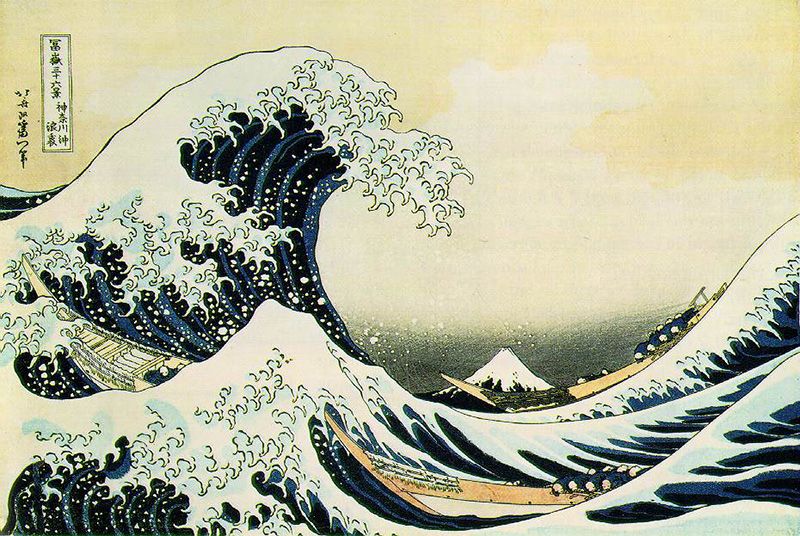
Hokusai. Great Wave off Kanagawa, from Thirty-six Views of Mount Fuji.
Hokusai’s Thirty-six Views was an immediate hit among the Japanese of the time, with its rendering of Japan’s most famous landmark in a variety of masterful compositions—sometimes viewed in the far distance above an Edo townscape or through the hollow of a wave, at other times dominating the entire picture surface. Not content with this tour de force, however, Hokusai produced an additional 10 prints for a grand total of 46 views. In addition, he left us Fugaku hyakkei (One Hundred Views of Mount Fuji), consisting of a three-volume set of prints bound in book form. And Fuji appears in a number of other Hokusai works as well, including two ink paintings: Shiohigari-zu (Shell Gathering), in which the stunning image of a snow-capped Fuji rises in the background of a scene portraying people amusing themselves by digging for clams at low tide, and Fuji-koshi no ryū (Dragon Flying over Mount Fuji), a work dating from the ninetieth and last year of Hokusai’s long life (1760–1849). It seems clear that this tireless genius of Japanese painting remained enchanted by Fuji throughout his prolific career.
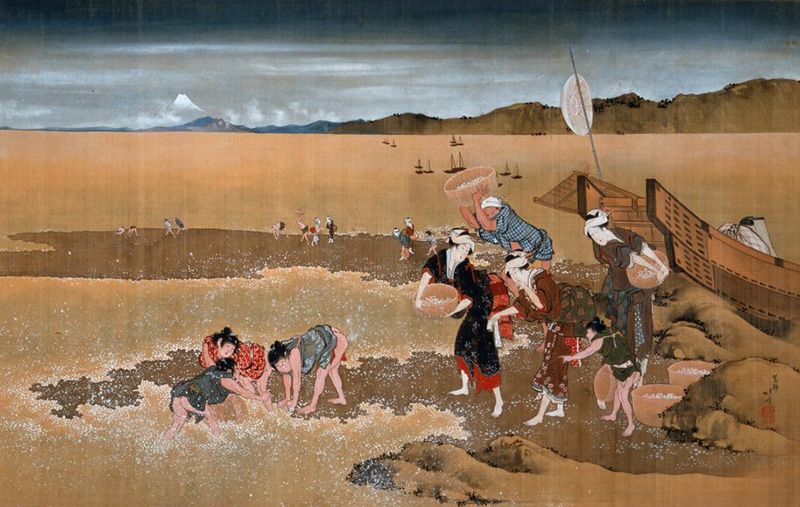 Hokusai. Shell Gathering. (Osaka Municipal Museum of Art)
Hokusai. Shell Gathering. (Osaka Municipal Museum of Art)
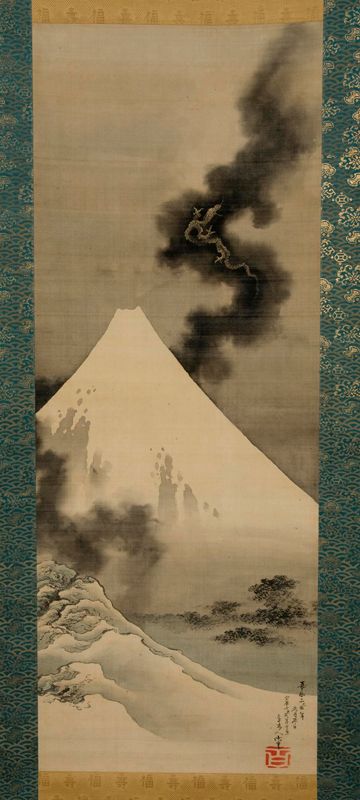 Hokusai. Dragon Flying over Mount Fuji. (Hokusaikan)
Hokusai. Dragon Flying over Mount Fuji. (Hokusaikan)
A Mountain Defined in Art
But Hokusai was scarcely unique in this respect. It would be difficult to identify a well-known painter of the Edo period (1603–1868) who did not leave behind at least one work connected to Fuji in some manner. Countless Fujis can be found in landscape and genre paintings, screens and scrolls, mandalas, and maps, not to mention textiles and ceramics.
This trend was particularly pronounced in the world of ukiyo-e, a genre beloved of the middle class. Demand for pictures soared as the cult of Mount Fuji and the custom of making pilgrimages up the mountain spread among the general populace, and in response many ukiyo-e masters began producing prints and books on the subject. Among these was another late-Edo-period master of landscape art, Andō Hiroshige (1797–1858). Partly as an answer to Hokusai, Hiroshige decided to publish a bound series of 100 views of Fuji. This project was abandoned after the publication of the initial 20-print volume, but Hiroshige has left two different series of 36 views in emulation of Hokusai. In addition, Mount Fuji figures prominently in Hiroshige’s best-known series, Tōkaidō gojūsantsugi (Fifty-three Stations of the Tōkaidō), and his late work Meisho Edo hyakkei (One Hundred Views of Edo). Ukiyo-e such as these were produced in great quantity, serving not just as objects of aesthetic appreciation but also as souvenirs for travelers and tourists, and the frequency with which Fuji appears in these mass-produced works gives us a good idea of its prominent place in the nation’s collective consciousness.
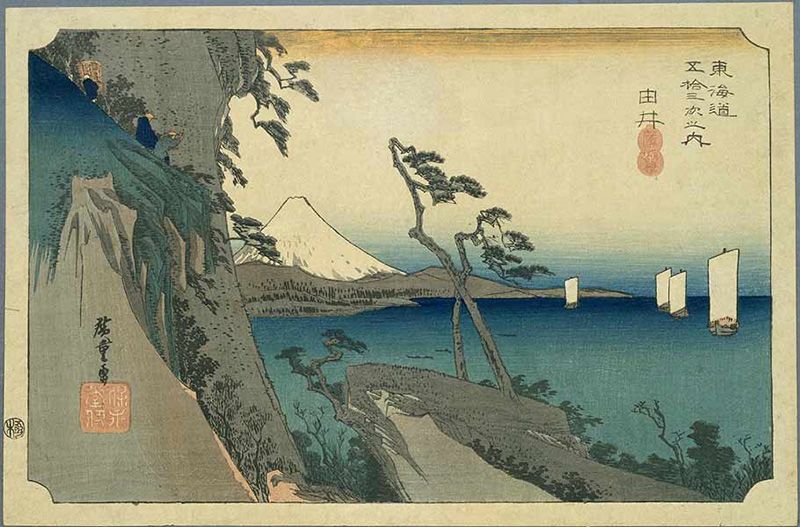
Hiroshige. Yui, from Fifty-three Stations of the Tōkaidō.
With its awe-inspiring beauty, impressive height (it is by far the tallest mountain in Japan), and central location, Mount Fuji had captured the Japanese imagination long before the Edo period. It is eulogized in several poems of the Man’yōshū, Japan’s oldest poetry anthology—including the famous chōka (long poem) by Yamabe no Akahito beginning, “Since heaven and earth parted, divine and lofty in Suruga soars the high peak of Fuji . . .” —and thereafter appears frequently in Japanese prose and poetry. In the realm of painting, the oldest extant rendering of Mount Fuji occurs in the mid–eleventh-century Shōtoku Taishi eden (Pictorial Biography of Prince Shōtoku) illustrating a legend in which the prince mounts a black horse sent him from Kai Province (present-day Yamanashi Prefecture) and rides it to the summit of Mount Fuji. This is a story that grew in popularity as the cult of Prince Shōtoku spread, and since Fuji invariably appeared in illustrations of it, it helped etch the image of the mountain in people’s consciousness. In the Kamakura period (1185–1333), Fuji appears in such handscrolls as the Yugyō shōnin engi e, which tells the story of Ippen, a well-known priest who traveled about the country spreading a sect of Buddhism based on the chanting of a mantra-like nenbutsu. Pure landscape paintings treating Mount Fuji can also be found prior to the Edo period.
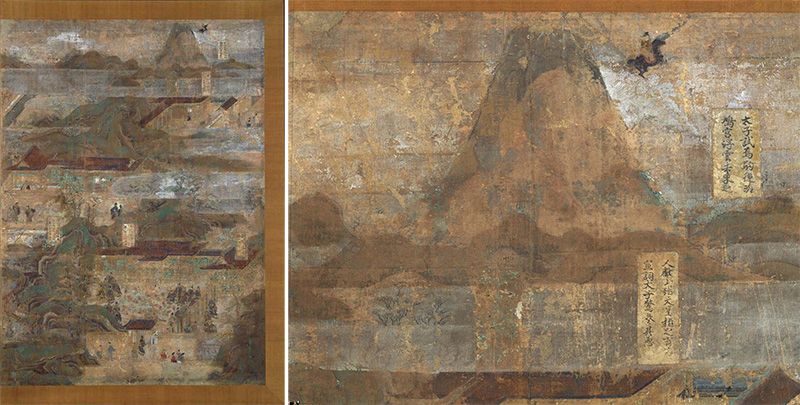 Hata no Chitei, Pictorial Biography of Prince Shōtoku. (Tokyo National Museum)
Hata no Chitei, Pictorial Biography of Prince Shōtoku. (Tokyo National Museum)
But the Edo period witnessed an important change in the relationship between Mount Fuji and the Japanese people. It was then that Fuji became a familiar presence in the lives of the common people, as its treatment by Hokusai and Hiroshige suggests. A major reason for this change was the rise of Edo (present-day Tokyo) as the seat of the Tokugawa shogunate and the country’s major population center.
Edo and Mount Fuji
As long as Japan was ruled from such capitals as Nara and Kyoto, Mount Fuji was known to most Japanese by reputation only, since relatively few people ever traveled to the remote eastern province where the mountain stood. But for the residents of Edo, Fuji was part of the everyday landscape.
On a clear day in contemporary Tokyo, one can sometimes make out Mount Fuji’s silhouette from the top of one of the city’s skyscrapers. But Fuji was a far more familiar and more imposing sight to the typical citizen of Edo. If ukiyo-e prints at times exaggerated its scale relative to the Edo townscape, it is because that is the way the residents of Edo perceived it in their mind’s eye.
The feudal lord Ōta Dōkan built Edo castle around the middle of the fifteenth century, when the town was still a backwater. A man of refined tastes, Dōkan enjoyed gazing out on the sacred peak of Mount Fuji from his sitting room, a sight he extolled in a poem on the theme: “My retreat stands in a pine grove near the seashore / With the lofty peak of Fuji rising beyond the roof eaves.”
For Dōkan, Mount Fuji was part of the everyday landscape, and the same was true for the residents of Edo even after it grew into Japan’s largest city. Out of the 120 prints sold as Hiroshige’s One Hundred Views of Edo (including the cover and a print added by another artist after Hiroshige’s death), there are 19 that clearly depict Mount Fuji, including the very first print of the series—Nihonbashi yukibare (Nihonbashi, Clearing After a Snow). Here a dazzling white Fuji appears in the background of a scene of the bridge Nihonbashi covered in sparkling clean snow. Located in the heart of Edo’s shitamachi—the “low town” where commercial activity and middle-class residences were concentrated—Nihonbashi offered a superb view of Fuji, and for the Edo populace one of the highlights of the annual event calendar was the “first viewing of Fuji” from Nihonbashi bridge on the third day of the first month of the year.
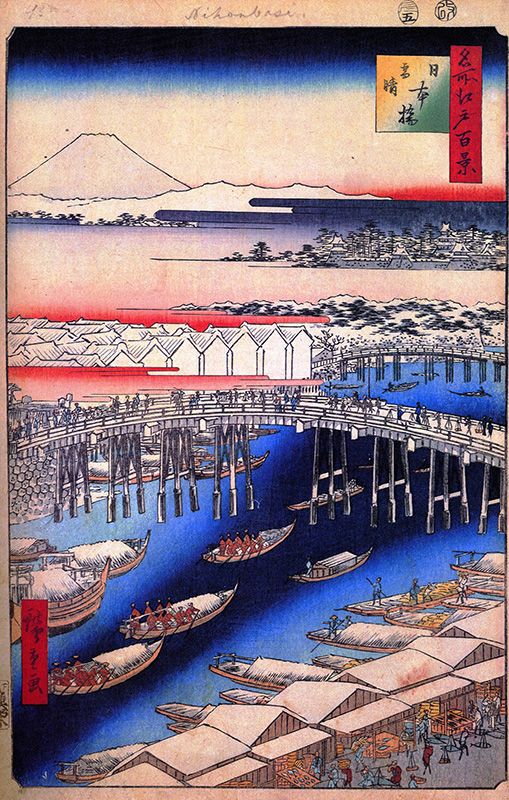
Hiroshige. Nihonbashi, Clearing After a Snow, from One Hundred Views of Edo.
Another representative portrayal of Fuji in the One Hundred Views of Edo is that seen in the print Suruga-chō. Using Western-style perspective to render depth, Hiroshige makes the horizontal lines of the street and its shop fronts converge toward a central vanishing point and depicts a majestic Fuji rising directly above that point like a great umbrella sheltering the street. This view was no accident; many of the streets of Edo were laid out to point directly toward Fuji, including this one, which was named after Suruga Province (modern-day Shizuoka Prefecture), where Mount Fuji was located. Many of Edo’s streets and neighborhoods were given names that alluded to Mount Fuji, another token of the familiarity with which the citizens of Edo viewed the mountain. (Quite a few of these names—such as Suruga-dai and Fujimi-chō—remain in use today.) In fact, Mount Fuji played an important role in the blueprint of the “new” Edo that arose after the establishment of the Tokugawa shogunate in 1603.
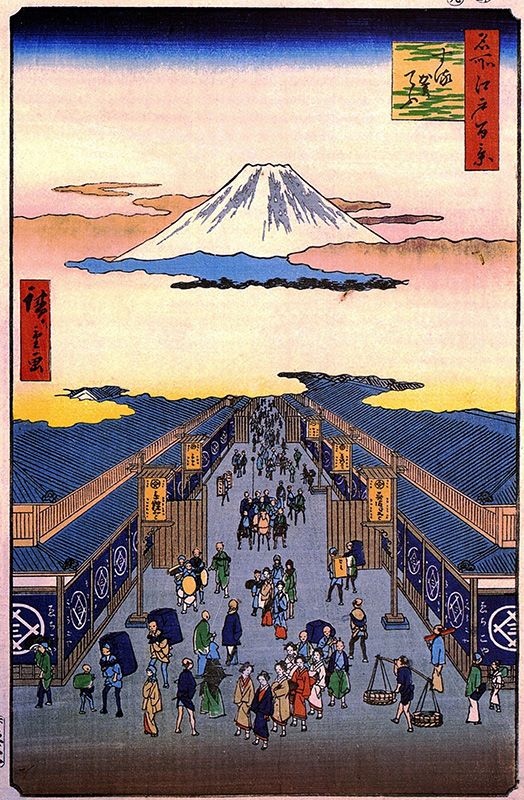
Hiroshige. Suruga-chō, from One Hundred Views of Edo.
Beginning with the ancient capitals of Heijōkyō (Nara) and Heiankyō (Kyoto), Japanese cities differed from their typical Chinese and Western counterparts in that they were not walled and thus lacked a clear outer boundary. They also lacked the imposing monuments—triumphal arches, pillars, and such—that served as landmarks and symbols in the West. In Japanese cities, the role of landmark was performed not by artificial structures but by visible mountains in the area—Kyoto’s Higashiyama, for example. In the case of Edo, there were two such landmarks: Mount Tsukuba to the north and Mount Fuji to the west. Edo was planned according to the principles of feng shui geomancy, which called for a highway leading to the west; the Tōkaidō, which started at Nihonbashi, was that highway, and its landmark, when viewed from Edo, was Mount Fuji.
Such was the affection and reverence in which Edoites held Mount Fuji that they went so far as to build a number of miniature replicas—called fujizuka—within the city. As the cult of Fuji spread during the Edo period, it became very popular to ascend the mountain by one means or another. The fujizuka were provided for those who were unable to climb the real Fuji. Although tiny compared to the real thing, the fujizuka depicted in the print of the Meguro shin-Fuji (New Miniature Mount Fuji in Meguro) in Hiroshige’s One Hundred Views of Edo is about 15 meters tall and is complete with a Shintō torii gate at the bottom and an approach leading to a miniature shrine, as well as a path by which visitors could climb to the summit. Meguro had an older miniature Fuji as well—also illustrated in the One Hundred Views of Edo—and according to records, both the new and old fujizuka attracted numerous visitors. Altogether there were seven miniature Fujis in Edo, some of which still stand today. Clearly, Mount Fuji was integral to the life of the city.
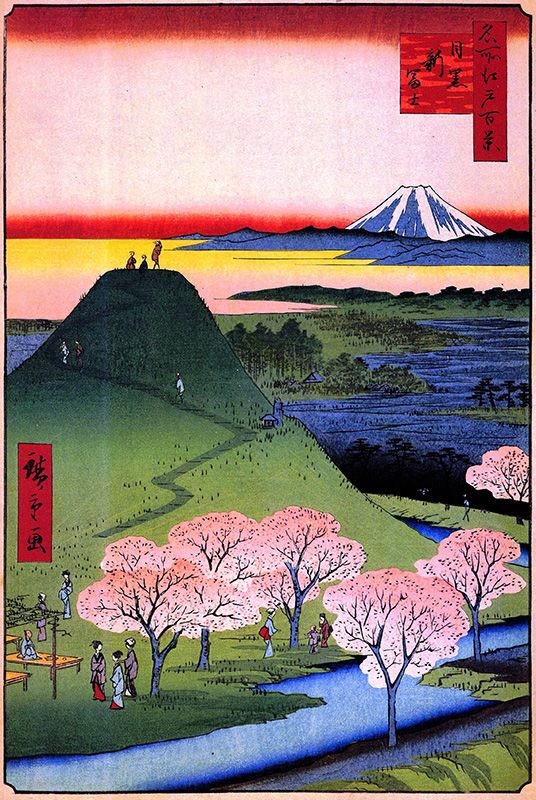
Hiroshige. New Miniature Mount Fuji in Meguro, from One Hundred Views of Edo.
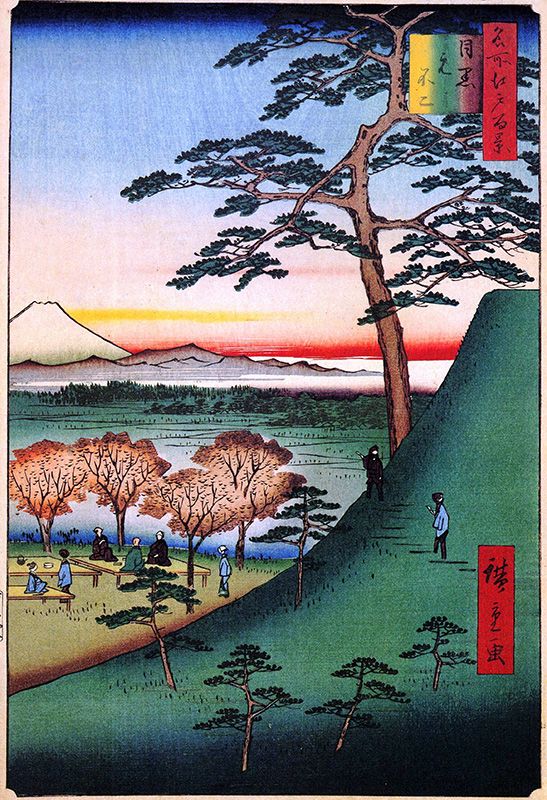
Hiroshige. Meguro moto-Fuji (Original Miniature Mount Fuji in Meguro), from One Hundred Views of Edo.
Fuji as an Object of Worship
The first fujizuka was built by members of a group known as a Fuji kō, an association dedicated to the ascent of Mount Fuji as religious exercise. Each Fuji kō would raise funds to sponsor annual pilgrimages in which one-fifth to one-third of the members would participate, so that by the end of three to five years all of the members would have completed the climb at least once. Since these excursions were religious in nature, the participants would first visit Sengen Shrine at the foot of the mountain and perform ablutions. They would then climb the mountain in the white robes of religious ascetics and pay homage at the shrine at the summit. After that, the group would descend along a different route to one of the towns at the foot of the mountain, where they would enjoy food, drink, and entertainment. With a group of 20 or 30 pilgrims, a professional guide, and a set itinerary that included lodgings, these trips might be regarded as the Edo-period equivalent of today’s package tours.

Hokusai. Morobito tozan (Groups of Mountain Climbers), from Thirty-six Views of Mount Fuji.
The Fuji kō, which also performed incantations and prayers for the sick and sold charms to ward off misfortune, became extremely popular. In fact, despite repeated interdicts by the shogunate, which feared the spread of popular religions, they continued to proliferate, at one point numbering 808 within the city of Edo alone, according to contemporary records. For the citizens of Edo, then, Mount Fuji was not merely the most familiar landmark but also one of the most familiar objects of religious worship.
Since ancient times the Japanese have regarded mountains with a special reverence, whether worshiping them as kami in their own right or using them as places to engage in the religious austerities of Shugendō, a sect based on mountain asceticism. Mount Fuji in particular has been venerated as a sacred peak from time immemorial.
There is reason to believe that the Jōmon-period site at Fujinomiya, a locale that enjoys an excellent view of Fuji, was a sanctuary where the earliest Japanese worshiped the mountain. And among the chōka on the subject of Mount Fuji in the Man’yōshū is one by Takahashi no Mushimaro in which the poet suggests that the mountain is “the god that is the guardian of Yamato, the land where the sun rises”—in other words, the mountain of the god that protects all of Japan.
In addition, the Nihon ryōiki (a ninth-century collection of religious tales) records that En no Gyōja, the founder of Shugendō, ascended Mount Fuji every night when he was banished to Izu. Like the aforementioned legend of Prince Shōtoku ascending Fuji on a horse, stories of this nature testify to the special mystique Mount Fuji had for the Japanese people.
In the ninth-century Fujisan-ki, Miyako no Yoshika writes that Fuji is where supernatural beings gather for recreation, and further that two beautiful women in white robes had been seen dancing at the summit during a festival in the eleventh month of the year 875. By this time there was a widespread belief that Fuji was the dwelling place of Asama, the goddess of volcanoes, and a shrine had been erected at the foot of the mountain to honor her. Although inactive for the past three centuries, Mount Fuji erupted repeatedly prior to that time, and the sight of the mountain spewing black smoke and even at times “divine fire” (gojinka) into the sky must have intensified the impression that the mountain contained a fathomless power.
Taketori monogatari (trans. The Tale of the Bamboo Cutter), regarded as Japan’s oldest work of fiction, touches on this aspect of Mount Fuji near the conclusion, which also attempts to explain the origin of the name Fuji. After the heroine Kaguya-hime returns to the moon, the emperor orders that the elixir of immortality she has left behind be burned on the summit of the mountain closest to heaven. For this reason, we are told, black smoke can always be seen rising from the mountain, whose name derives from the word for immortality, fushi. Whether or not this etymology is correct, the story clearly reflects the sense of awe the mountain doubtless inspired in those who saw it breathing smoke and fire. Sarashina nikki (trans. As I Crossed a Bridge of Dreams), a travel diary written in the eleventh century, offers a terse but apt description of this unforgettable view: “The mountain’s aspect scarcely seems of this world. . . . Smoke rises from the small flat area at the summit, and in the evening one can see fires burning.”
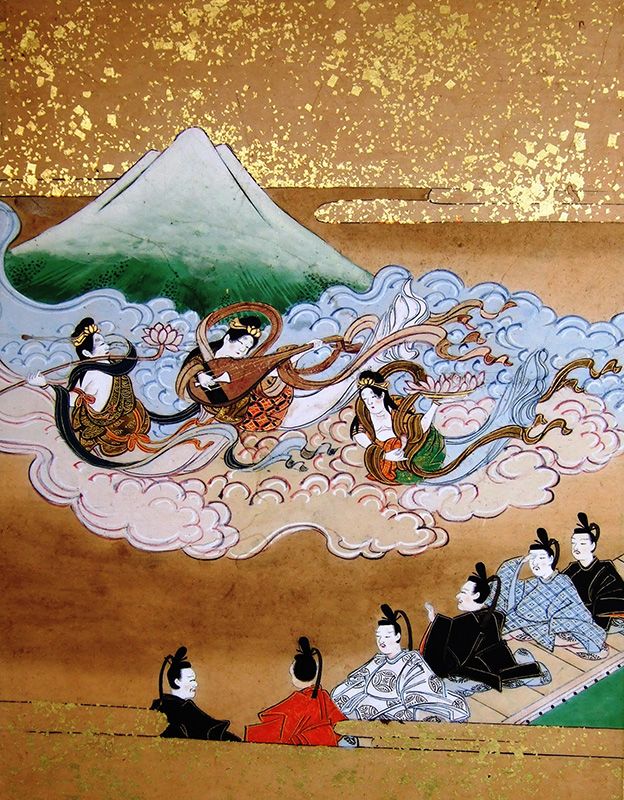 Heavenly Beings Arrive to Escort Kaguya-hime on Her Return to the Moon, from a painted folding screen depicting Taketori monogatari. (Rikkyō University Library)
Heavenly Beings Arrive to Escort Kaguya-hime on Her Return to the Moon, from a painted folding screen depicting Taketori monogatari. (Rikkyō University Library)
These fires were used as an artistic motif in the superb design of a woolen jinbaori, or campaign coat (a long vest worn over armor) said to have been a favorite of Toyotomi Hideyoshi’s. The image of Mount Fuji covers the back of the garment. “Divine fire” swirls above the mountain, while a motif of large round “water droplets” accents the lower portion. It is a masterful composition and a bold and effective textile design. The Fuji motif was frequently used to decorate military equipment, including helmets, armor, saddles, sword guards, and knives. One reason warriors may have been partial to it was the belief that Fuji was associated with immortality.
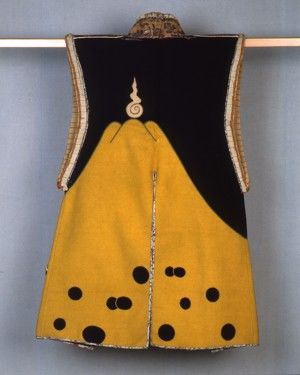
Surcoat bearing the design of Mount Fuji on yellow and black wool background. (Osaka Castle Museum)
Fuji was in fact the focus of many religious beliefs. During the medieval period, when Buddhism and Shintō were closely intertwined, a Buddhist temple was built at the top of Mount Fuji, and there even emerged a sect that preached that the Pure Land of the Buddha Amida lay at Fuji’s summit. A number of Fuji mandalas remain from the period, one of which displays an Amida triad (Amida flanked by the bodhisattvas Kannon and Seishi) superimposed on the summit, and another of which bears the words of the nenbutsu “Namu Amida Butsu.” Near the beginning of the Edo period, however, Fuji came to be associated primarily with the goddess Konohana no Sakuya Hime, who appears in the Kojiki, and she remains the mountain’s principal deity to this day.
In the realm of folk belief, Fuji is an enduring symbol of good fortune. To this day many Japanese believe that the first dream of the year is a harbinger of the year to come, and the luckiest first dream is a dream of Mount Fuji.
The religious beliefs surrounding Mount Fuji thus embrace aspects of Shintō, Buddhism, Taoism (Shugendō), and folk religion. Through all these tangled strands, Fuji is inextricably bound to the hearts of the Japanese people.
Fuji and Travel
While the mountain-climbing pilgrimages of the Fuji kō were ostensibly religious in nature, they were also a form of tourism—an opportunity for the people of Edo to see unfamiliar scenery, visit new towns, experience novel customs and events, and simply “get away from it all.” The same was true of the pilgrimages to Ise and to Mount Kotohira in Shikoku, both sites of famous shrines. On the basis of contemporary documents, including reports submitted to the shogunate by the magistrate of Yamada in Ise at the beginning of the eighteenth century, historians have estimated that between 500,000 and 600,000 people visited Ise Shrine in a typical year. In years when special ceremonies were held, several times that number converged on Ise from all parts of Japan. Lodgings, information centers, and souvenir shops lined the streets around the shrine and those of the towns along the highway that led there. In addition to visiting the shrine, which was of course the main purpose of going to Ise, pilgrims also enjoyed seeing the sights along the way. Going to Ise was something that people of all sorts could do fairly easily and safely, and records of the time indicate that there were many women and children among the pilgrims.
Travel in general was extremely popular during the Edo period. Of course, it was nothing new to the Japanese, as such deservedly famous diaries as the Tosa nikki (935; trans. The Tosa Diary) of Ki no Tsurayuki and Izayoi nikki (ca. 1280; trans. Journal of the Sixteenth-Night Moon) of Abutsu Ni attest. But the Edo period saw an unprecedented volume of traffic for a number of reasons. The sankin kōtai system instituted by the shogunate required feudal lords and their households to travel back and forth between their domains and Edo, and the rapid growth of commerce necessitated the movement of goods. Meanwhile, as the peace established by the Tokugawa shogunate continued, people became curious to see famous sights in other parts of the country, and they began to consider travel an attractive form of recreation. In response to these trends, roads were opened and inns sprang up along them, while the development of a postal system provided a nationwide communications network. All these factors combined to trigger an explosion in the number of people on the country’s highways. And the busiest of these highways was the main road connecting the rapidly developing city of Edo in the east with Kyoto and Osaka in the west: the Tōkaidō. The allure of travel on the Tōkaidō and the grip that highway had on the collective imagination of the Japanese is suggested by the explosive sales of Jippensha Ikku’s picaresque “on the road” novel Tōkaidōchū hizakurige (1802–9; trans. Shank’s Mare) and the immense popularity of Hiroshige’s Fifty-three Stations of the Tōkaidō series, of which three distinct versions were published.
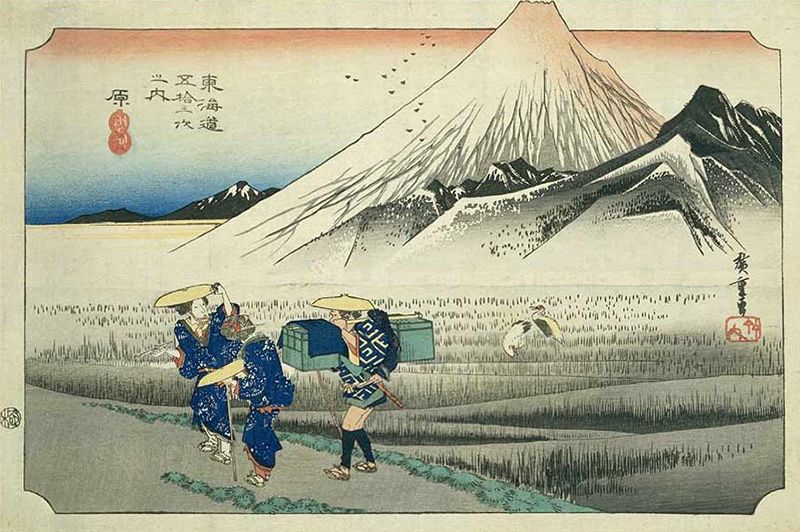
Hiroshige. Hara, from Fifty-three Stations of the Tōkaidō.
One of the pleasures of a journey on the Tōkaidō was the view of Mount Fuji available at various locales along the way. Fuji in all its splendor figures prominently in the numerous illustrated itinerary maps and guides produced during the Edo period. The mountain’s beauty is frequently extolled in the many travel diaries and travelogues that remain to us from that time, and a traveler’s glimpse of the mountain was a common subject among painters and poets alike. In his Nozarashi kikō (1685; trans. The Records of a Weather-Exposed Skeleton), the famed haiku poet Bashō—an enthusiastic traveler—wrote the following poem after passing through the Hakone Barrier in the rain and finding Fuji obscured by clouds.
Mist and drizzle—
Today it was interesting
Not to view Fuji.
Fuji, one might say, is etched so deeply in the heart of the poet that it appears to him even when hidden from view. And in the eighteenth century, the Kyoto poet-painter Buson, recalling a journey to Edo, wrote the following haiku, conjuring imagery as vivid as any painting.
Fuji alone
Left uncovered by
The new leaves.
Together with the descriptions of ordinary travelers, such works of literature and art played an important role in disseminating the image of Fuji and engraving it on the nation’s collective consciousness.
The prominent position the mountain occupied as an object of universal admiration is evidenced by the custom, beginning as early as the Edo period, of nicknaming local mountains “Fuji” preceded by the name of the region. Two examples were Mount Iwaki in Aomori Prefecture (Tsugaru Fuji) and Mount Kaimondake in Kagoshima Prefecture (Satsuma Fuji). In modern times, these local Fujis have proliferated, reaching a nationwide total of about 350. The degree to which all of these mountains actually resemble the more famous peak is debatable, but their names alone speak eloquently of the unique place Mount Fuji occupies in the hearts of the Japanese.
(Originally written in Japanese. First published in Japan Echo, Vol. 30 No. 1 [February 2003].)
Edo period art Mount Fuji Katsushika Hokusai ukiyo-e Fugaku Sanjurokkei Thirty-six Views Ando Hiroshige Tokaido culture mountain